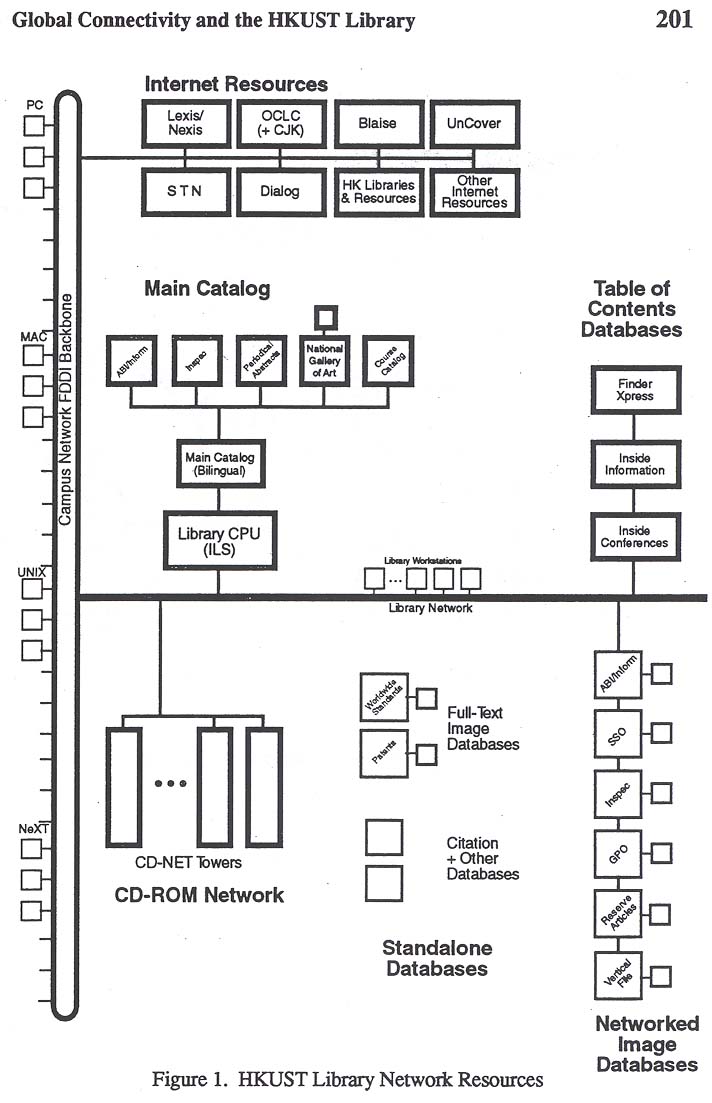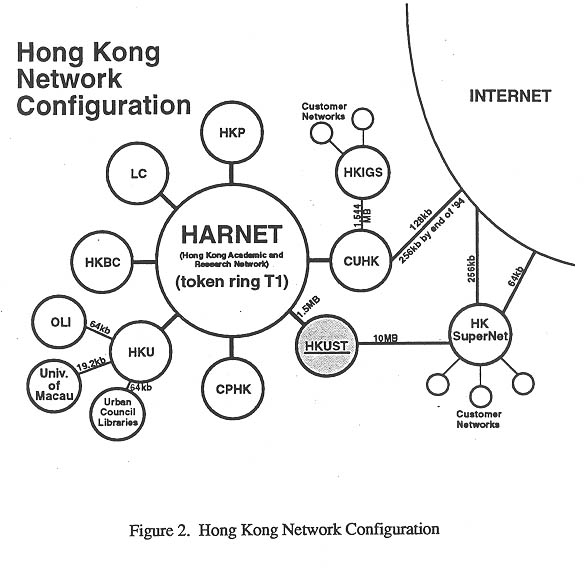

PANEL ON
GLOBAL LIBRARY, CULTURAL AND HERITAGE INFORMATION NETWORK, AND ELECTRONIC
INFORMATION SHARING
GLOBAL CONNECTIVITY AND THE HKUST LIBRARY
Minmin Chang
Head Librarian
Hong Kong University of Science & Technology
Clear Water Bay, Kowloon, Hong Kong
Minmin@usthk.ust.hk
[Introduced by Ching-chih Chen]
Many of you were at NIT '92 held at the Hong Kong University of Science and Technology, where Minmin Chang is the Director of Libraries. She is also the Local Chair for NIT '92. I already mentioned that HKUST is considered to be one of the most high-tech oriented universities. Most excitingly, they are known not because they have money and therefore the technology is there, but also because they actually are doing some very exciting things. Minmin realizes that she is the only person who came from the region, and there is no paper for that. So, she agrees to take a few minutes to share with us her experience at HKUST and how their work can tie in to information activities in Hong Kong and other countries in the region. So, thank you very much Minmin.
The Hong Kong University of Science and Technology (HKUST) opened in October 1991 for its first student intake. Established as the third university in Hong Kong, this university's mandate was to become a world class research university with an emphasis on science, engineering, and business, and a heavy component of postgraduate studies.
The university library was required to support the university's teaching and research programs right from the beginning. Although building a library from scratch, with a lead time of less than two years, was a tremendous challenge, the advances in information technology and telecommunications, together with developments in electronic publishing, have enabled the HKUST Library to offer its users unprecedented capabilities in accessing and retrieving information. When the Library opened in October 1991, in addition to a modest print collec-tion and a large number of electronic publications and databases, library users could also access the online catalogs of many great research libraries throughout the world both from the gateway of its online system as well as through OCLC. HKUST had an instant research library!
The HKUST Library Online System is connected to the campus FDDI back-bone and, thus, is accessible to its users throughout the campus. From the outset, the online system was designed to take full advantage of the available informa-tion technology. A flexible structure was conceived to utilize a variety of auto-mation tools to support network access and delivery of information resources (See Figure 1). At the heart of this structure is the integrated library system. In addition to the library's complete catalog of books, journals, and other resources, the online system contains the six most frequently used journal citation data-bases. Also available on the campus local area network (LAN) are full-text image databases and an extensive CD-ROM network of 152 drives distributing more than 40 databases. The full-text image databases in the fields of the physi-cal sciences, engineering, business, and social sciences can provide the image copy of many of the article citations retrieved from the journal citation databases loaded in the library catalog. Users may also make online requests for articles not available in the library. Furthermore, about 40 other CD-ROM publications and multimedia databases are installed on stand-alone workstations. The issue of "access versus ownership" has been carefully assessed in the HKUST library. It is a basic element in our collection development process. Our goal is to provide the essential and frequently used materials locally and to connect globally for other materials. The HKUST library serves as a good example to illustrate the importance of global connectivity among libraries and information centers. Without it this new library would have a hard time fulfilling its mission.
The HKUST is connected to both the Hong Kong Academic
and Research Network (HARNET) and the Hong Kong SuperNet as shown in Figure
2.


Q & A_________________
DISCUSSIONS
[Ching-chih Chen]
Thank you very much, Minmin. As you can see, when we talk about the haves and have-nots, this is definitely a "have." When we held NIT '92 in Hong Kong, I was so nervous because we had our conference in a very luxurious environment and with a lot of fancy things -- in such a highclass place with lots of money. I was very afraid that the NIT participants were spoiled in that type of environment, which will be very difficult for us to match in future conferences. With Minmin's presentation, you can understand why I was worried. At any rate, with the Hong Kong's SuperNet, maybe Minmin can volunteer to help us establish a NIT SuperNet so that we can connect everyone together using their facilities. Any comments from the floor before we move on?
[Woody Horton]
To what extent can the end-users use these services in your dormitories or at home without walking to the library?
[Minmin Chang]
Everything is available on the campus network, except
the stand-alone databases. The commitment to building an "electronic library"
affects planning and management decisions at every stage. One important
aspect in our many choices is how best to balance electronics with print
and nonprint materials, emphasizing new technology when appropriate without
neglecting the library's traditional core of books and journals in paper.